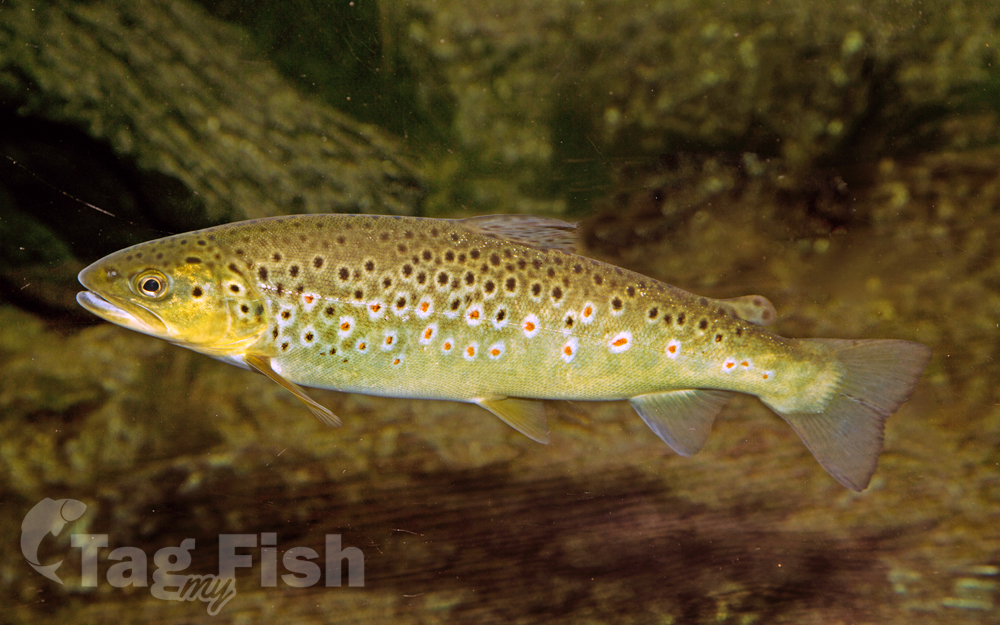Brown trout
(Salmo trutta)

Classification
General data
The brown trout (Salmo trutta) is a European species of salmonid fish that has been widely introduced into suitable environments globally. It includes purely freshwater populations, referred to as the riverine ecotype, Salmo trutta morpha fario, a lacustrine ecotype, S. trutta morpha lacustris, also called the lake trout, and anadromous forms known as the sea trout, S. trutta morpha trutta. The latter migrates to the oceans for much of its life and returns to fresh water only to spawn.[5] Sea trout in Ireland and Great Britain have many regional names: sewin in Wales, finnock in Scotland, peal in the West Country, mort in North West England, and white trout in Ireland.
The lacustrine morph of brown trout is most usually potamodromous, migrating from lakes into rivers or streams to spawn. S. trutta morpha fario forms stream-resident populations, typically in alpine streams, but sometimes in larger rivers. Anadromous and non-anadromous morphs coexisting in the same river appear genetically identical. What determines whether or not they migrate remains unknown.
The brown trout is a medium-sized fish, growing to 20 kg (44 lb) or more and a length of about 100 cm (39 in) in some localities, although in many smaller rivers, a mature weight of 1 kg (2.2 lb) or less is common. S. t. lacustris reaches an average length of 40–80 cm (16–31 in) with a maximum length of 140 cm (55 in) and about 60 pounds (27 kg).
Introduction outside their natural range
Brown trout have been widely introduced into suitable environments around the world, including North and South America, Australasia, Asia, and South and East Africa. Introduced brown trout have established self-sustaining, wild populations in many introduced countries.
The first introductions were in Australia in 1864 when 300 of 1500 brown trout eggs from the River Itchen survived a four-month voyage from Falmouth, Cornwall to Melbourne on the sailing ship Norfolk. By 1866, 171 young brown trout were surviving in a Plenty River hatchery in Tasmania. Thirty-eight young trout were released in the river, a tributary of the River Derwent in 1866. By 1868, the Plenty River hosted a self-sustaining population of brown trout which became a brood source for continued introduction of brown trout into Australian and New Zealand rivers.
Successful introductions into the Natal and Cape Provinces of South Africa took place in 1890 and 1892, respectively. By 1909, brown trout were established in the mountains of Kenya.
The first introductions into the Himalayas in northern India took place in 1868, and by 1900, brown trout were established in Kashmir and Madras. In the 1950s and 1960s, Edgar Albert de la Rue [, a French geologist, began the introduction of several species of salmonids on the remote Kerguelen Islands in the southern Indian Ocean. Of the seven species introduced, only brook trout, Salvelinus fontinalis, and brown trout survived to establish wild populations.
The first introductions in Canada occurred in 1883 in Newfoundland and continued until 1933. The only Canadian regions without brown trout are Yukon and the Northwest Territories.
Introductions into South America began in 1904 in Argentina. Brown trout are now established in Chile, Peru and the Falklands. Sea-run forms of brown trout exceeding 20 lb (9.1 kg) are caught by local anglers on a regular basis.
The first introductions into the U.S. started in 1883 when Fred Mather, a New York pisciculturist and angler, under the authority of the U.S. Fish Commissioner, Spencer Baird, obtained brown trout eggs from a Baron Lucius von Behr, president of the German Fishing Society . The von Behr brown trout came from both mountain streams and large lakes in the Black Forest region of Baden-Württemberg.











